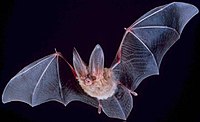Nocturnality
This article needs additional citations for verification. (July 2007) |

As an animal behavior, nocturnality describes sleeping during the daytime and being active at night - the opposite of the diurnal human lifestyle, and that of those animals with which we are most familiar. The intermediate crepuscular schedule (twilight activity) is also common. Some species are active both during the day and night. Living at night can be seen as a form of niche differentiation, where a species' niche is partitioned not by resources but by time itself, i.e. temporal division of the ecological niche. It can also be viewed as a form of crypsis, in other words an adaptation to avoid or enhance predation. There are other reasons for nocturnality as well, such as keeping out of the heat of the day. This is especially true in deserts, where many animals' nocturnal behavior prevents it from losing precious water during the hot, dry daytime. This is an adaptation that enhances osmoregulation.[1]
Many species which are otherwise diurnal exhibit some nocturnal behaviour; for example, many seabirds and sea turtles attend breeding sites or colonies nocturnally to reduce the risk of predation (to themselves or their offspring) but are otherwise diurnal.
Nocturnal animals generally have highly developed senses of hearing and smell, and specially adapted eyesight. In zoos, nocturnal animals are usually kept in special night-illumination enclosures to reverse their normal sleep-wake cycle and to keep them active during the hours when visitors will be attempting to see them.
Some animals, such as cats, have eyes that can adapt to both night and day levels of illumination. Others, e.g. bushbabies and bats, can only function at night.
A person who exhibits nocturnal habits is referred to as a night owl.
Examples

The following animals are generally classified as nocturnal:
- Aye-aye
- Badger
- Cat
- Centipedes
- Civet
- Cockroaches
- Flying squirrels
- Fox
- Giant White-tailed Rat
- Green Sea Turtle
- Hedgehog
- Hyena
- Kangaroo rats
- Kiwi
- Lion
- Lumholtz's Tree-kangaroo
- Moths
- Nightjars
- Oilbird
- Owls
- Potto
- Raccoon
- Red-legged Pademelon
- Skunk
- Sugar glider
- Tiger
- Tree frogs
- Western harvest mouse
- Whippoorwill
- Wombats
- Wolf
References
- ^ N.A.Campbell (1996) Biology (4th edition) Benjamin Cummings NY. ISBN 0-8053-1957-3
- The Nocturnal Society Bats are apaet
